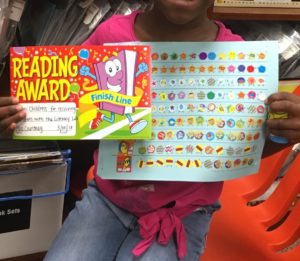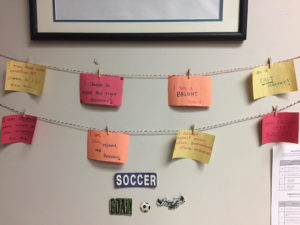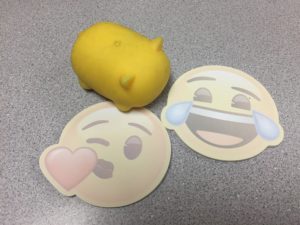Learning to read is hard work, and our growing readers deserve a little extra recognition every now and then! Literacy tutors use incentives when their students need help to stay focused and reach their reading targets. Some of our tutors shared their creative approaches to keeping students on track with incentives.
Miss Courtney’s Star Readers
 If a student meets all six of my table expectations, at the end of our intervention they can place a sticker on their chart. Once they reach the end of a row, the student can choose an item from the reward box. I present each student with a Reading Award and take their picture for Miss Courtney’s Star Readers bulletin board.
If a student meets all six of my table expectations, at the end of our intervention they can place a sticker on their chart. Once they reach the end of a row, the student can choose an item from the reward box. I present each student with a Reading Award and take their picture for Miss Courtney’s Star Readers bulletin board.
My students love seeing their picture on my Star Readers bulletin board. Once they fill up another row of their chart, I replace the photo with a new one and the student takes the other photo home. Many take their photo home to show their families and some give them to their teachers to display in the classroom. This reward technique allows my students to visualize their accomplishments.
Mariah & Lauren’s Affirmation Wall and Behavior Dollars
We have 2 major incentive techniques: our self-affirmation wall and Great  Leaps and behavior dollars. The self-affirmation wall is a nice reminder for our kids to realize their potential. They also love when we tell them that the affirmations are written specifically for them. It makes them feel special.
Leaps and behavior dollars. The self-affirmation wall is a nice reminder for our kids to realize their potential. They also love when we tell them that the affirmations are written specifically for them. It makes them feel special.
The Great Leaps and behavior dollars work great for setting a goal and “earning” their money to add to their wallet. We have a tiny shop of incentives (coloring pages, bookmarks, books, stress toys, etc). Our kids love having their own wallet and “money” of their own. It keeps them on track because they’re really determined to save up to shop.
Chelsea’s Comfort Pup and Emoji Post-Its
 Comfort pup is a stress ball used for my students who need an outlet for frustration or fidgeting in order to focus. Comfort pup, “a tool not a toy,” really helps some students readjust on their own and I noticed some kids can focus better when they have something in their non-tracking hand. Emoji post-its are used as good notes home for good behavior or new “high scores” achieved in Great Leaps. My students are really proud of their earned emojis. They show them off to their teacher and parents, who can praise and reinforce good work and behavior.
Comfort pup is a stress ball used for my students who need an outlet for frustration or fidgeting in order to focus. Comfort pup, “a tool not a toy,” really helps some students readjust on their own and I noticed some kids can focus better when they have something in their non-tracking hand. Emoji post-its are used as good notes home for good behavior or new “high scores” achieved in Great Leaps. My students are really proud of their earned emojis. They show them off to their teacher and parents, who can praise and reinforce good work and behavior.